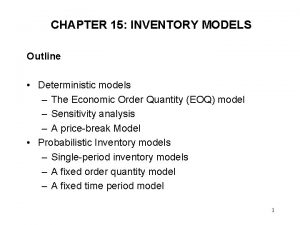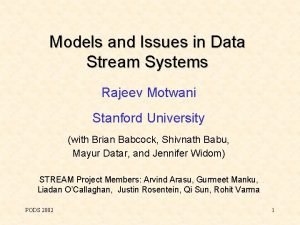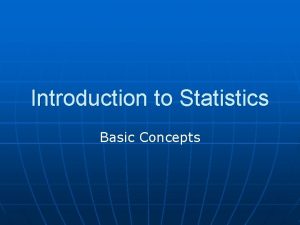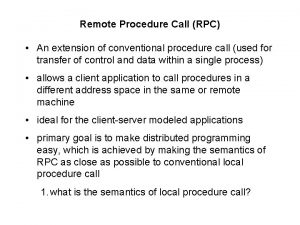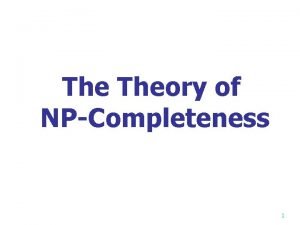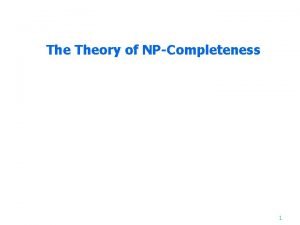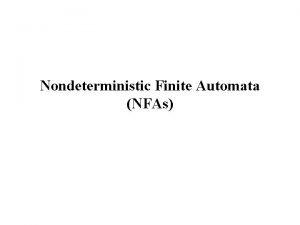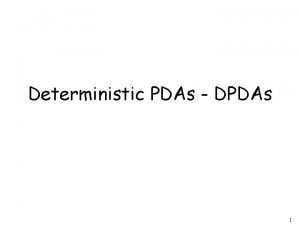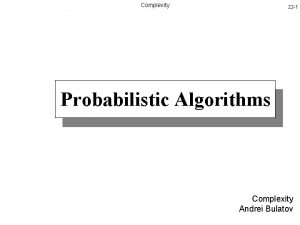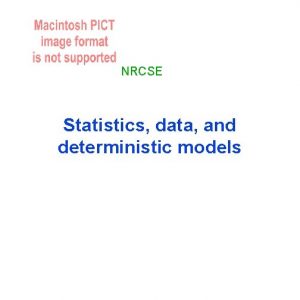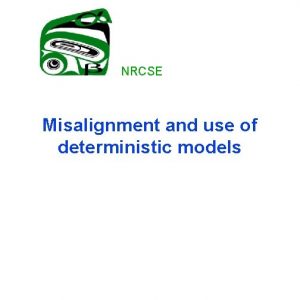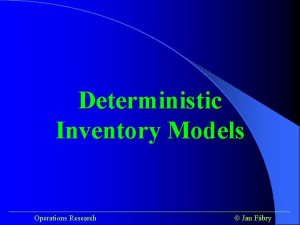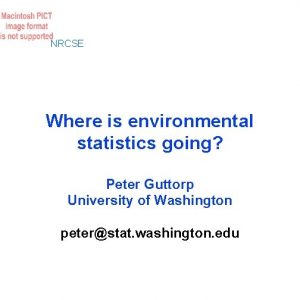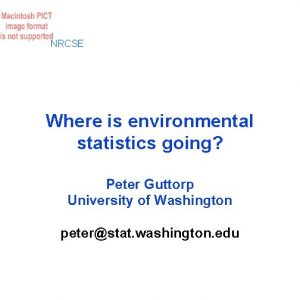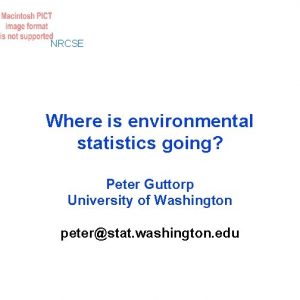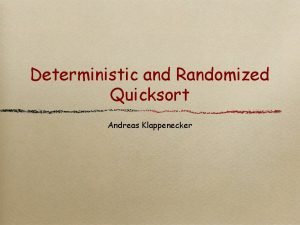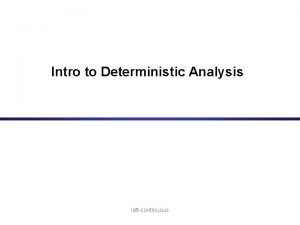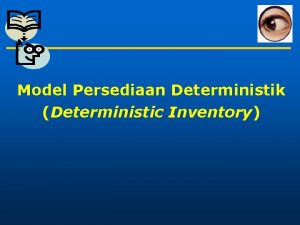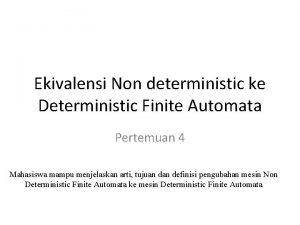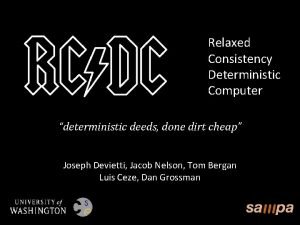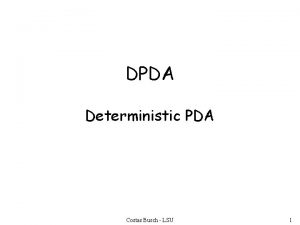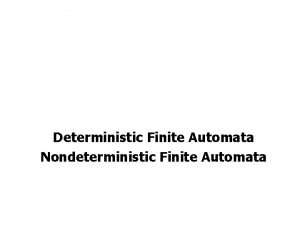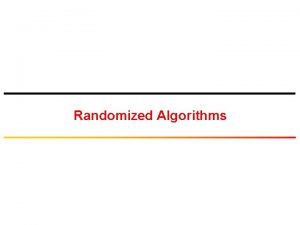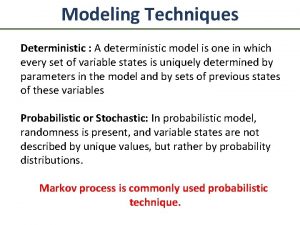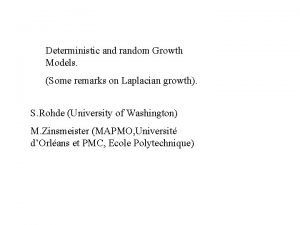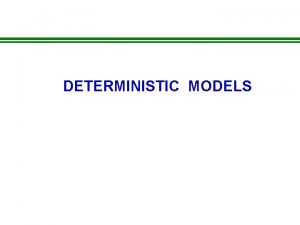NRCSE Statistics data and deterministic models Some issues




























- Slides: 28

NRCSE Statistics, data, and deterministic models

Some issues in model assessment Spatiotemporal misalignment Grid boxes vs observations Types of error Measurement error and bias Model error Approximation error Manipulate data or model output? Two case studies: SARMAP – kriging MODELS-3 – Bayesian melding Other uses of Bayesian hierarchical models

Assessing the SARMAP model 60 days of hourly observations at 32 sites in Sacramento region Hourly model runs for three “episodes”

Task Estimate from data the ozone level at x’s in a grid square. Use sum to estimate integral over grid square. Issues: Transformation Diurnal cycle Temporal dependence Spatial dependence Space-time interaction

Transformation Heterogeneous variability–mean and variance positively related Square root transformation All modeling now on square root scale– approximately normal

Diurnal cycle

Temporal dependence

Spatial dependence

Estimating a grid square average Estimate using (not averages of squares of kriging estimates on the square root scale)

Looking at an episode

Afternoon comparison

Nighttime comparison

A Bayesian approach SARMAP study spatially data rich If spatially sparse data, how estimate grid squares? P = Z + M + A + O = ( )Z + B + E P = process model output O = observations Z = truth Calculate (Z |P, O) for prediction Calculate (O |P, = 1, M = S = A = 0) for model assessment

CASTNet and Models-3 CASTNet is a dry deposition network Models-3 sophisticated air quality model Average fluxes on 36 x 36 km 2 grid Weekly data and hourly output

Estimated model bias The multiplicatice bias is taken spatially constant (= 0. 5). The additive bias E(M+A+ ) is spatially distributed.

Assessing model fit Predict CASTNet observation Oi from posterior mean of prediction using Models-3 output Pi and remaining observations O-I. Average length of 90% credible intervals is 7 ppb Average length using only Models-3 is 3. 5 ppb

Crossvalidation

The Bayesian hierarchical approach Three levels of modelling: Data model: f(data | process, parameters) Process model: f(process | parameters) Parameter model: f(parameters) Use Bayes’ theorem to compute posterior f(process, parameters | data)

Some applications Data assimilation Satellite tracking Precipitation measurement Combination of data on different scales Image analysis Agricultural field trials

Application to Models-3 where (I) are samples from the posterior distribution of ME IL NC IN FL MI CASTNet 0. 15 3. 29 0. 90 3. 14 0. 57 1. 02 Models-3 0. 33 3. 33 5. 32 9. 59 0. 52 1. 04 Adjusted Models-3 0. 12 2. 88 1. 09 3. 12 0. 44 1. 01

Predictions

NCAR-GSP (IMAGe) Theme for 2005: Data Assimilation in the Geosciences

ENSO project El Niño/Southern Oscillation is driven by surface temperature in tropical Pacific Data 2 ox 2 o monthly SST anomalies at 2261 locations; zonal 10 m wind Previous work indicates EOFs of SST may develop in a Markovian fashion Forecast 7 months ahead uses data from Jan 70 through latest available. Cressie-Wikle-Berliner (http: //www. stat. ohio-state. edu/ ~sses/collab_enso. php)

Model Data model: EOFs Process model: regimes winds Parameter model: The current state is a mixture over three regimes (determined by SOI), with mixing probabilities that depend on the wind statistic Standardize by subtracting climatology (monthly average 1971 -2000)

Latest ENSO forecast

data forecast Latest forecast with data

Relative performance Performance measure for anomalies: ave((forecast - data)2} over all pixels in Niño 3. 4 -region Relative Performance of Forecast A relative to Forecast B is RP(A, B)=log(Perf B / Perf A) RP(A, B)>0 indicates A better than B Persistence: Predict using data 7 months ago Climatology: Predict using 0

Comparison to climatology and persistence
 Deterministic demand vs stochastic demand
Deterministic demand vs stochastic demand Is inventory a stock
Is inventory a stock Deterministic and stochastic inventory models
Deterministic and stochastic inventory models Models and issues in data stream systems
Models and issues in data stream systems What is the difference between models & semi modals
What is the difference between models & semi modals Introduction to statistics and some basic concepts
Introduction to statistics and some basic concepts Statistics and ethics: some advice for young statisticians
Statistics and ethics: some advice for young statisticians Contact and non contact forces
Contact and non contact forces Some may trust in horses
Some may trust in horses Introduction to statistics what is statistics
Introduction to statistics what is statistics Is global warming an enduring issue
Is global warming an enduring issue Conventional procedure call
Conventional procedure call Sometimes you win some
Sometimes you win some They say sometimes you win some
They say sometimes you win some Cake is countable
Cake is countable Fire and ice diamante poem
Fire and ice diamante poem Some say the world will end in fire some say in ice
Some say the world will end in fire some say in ice Spanning tree of a graph
Spanning tree of a graph Non deterministic algorithm for sorting
Non deterministic algorithm for sorting Max clique problem
Max clique problem Social learning theory
Social learning theory Non-deterministic algorithm
Non-deterministic algorithm Finite automation
Finite automation Nondeterministic
Nondeterministic Deterministic vs statistical relationship
Deterministic vs statistical relationship Deterministic games examples
Deterministic games examples Deterministic seismic hazard analysis
Deterministic seismic hazard analysis Npda and dpda
Npda and dpda Andrei bulatov
Andrei bulatov

